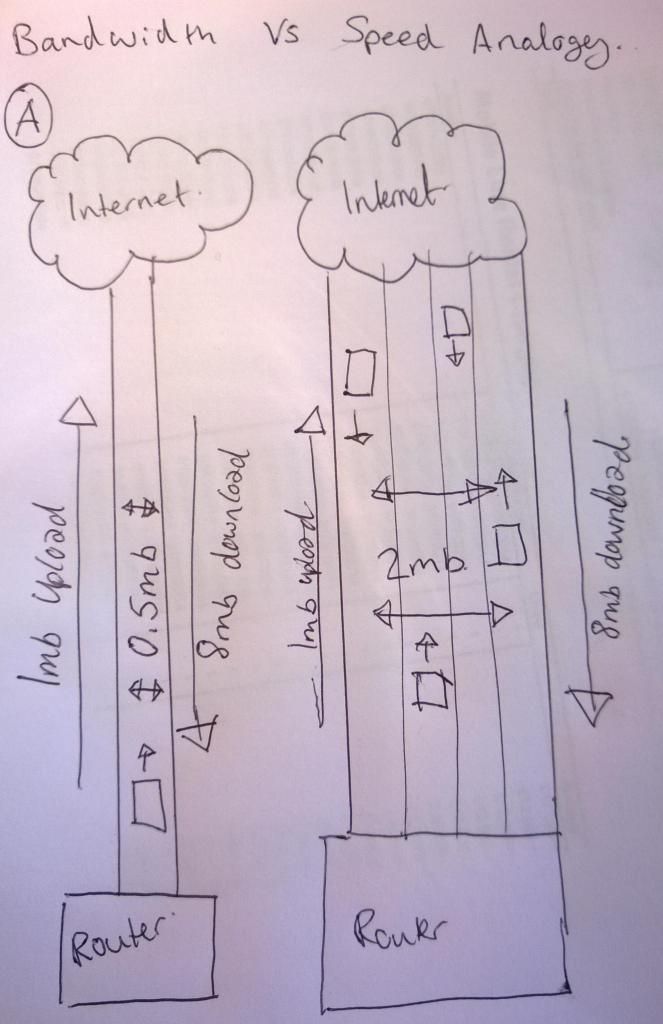Associate
- Joined
- 20 Aug 2007
- Posts
- 1,333
- Location
- Solihull
Hi guys, I'm trying to get to grips with this concept - it has perplexed me for quite a while now. I think it's a fairly common misconception that bandwidth relates to your download speed on things like speedtest.net
I believe I've come to a very vague understanding using dodgy diagrams in pen and some crap analogies.

The left diagram labelled A (I forgot to label the right one!) shows an example of a standard broadband connection. I've just used the numbers there as examples too.
Sooo..if we imagine it's a standard ADSL connection with a download SPEED of 8Mbps, an upload SPEED of 1Mbps and a BANDWIDTH of 0.5mb..this allows 500kb packets of data to travel downloads at speeds up to 8mbps and the same packet to upload at speeds of 1mbps..
I think this is correct, please say if not!
In the second example I am using the same SPEEDS but have quadrupled the bandwidth just for example purposes, so now it's a 2mb bandwidth.. here's where I'm going out on a limb..
This second example SHOULD allow 4 x 500kb packets of data to travel in any direction SIMULTANEOUSLY at the max up/down speed, if you're following?
OK BREAK TIME, NEED TO COLLECT THOUGHTS
And continuing..
The way I've made this into an analogy is using roads/motorways; if we imagine that the download speed is the road speed limit for this example, and the bandwidth is the amount of lanes on said road.
So a speed limit of "70mph" or 8mbps is on a single lane, it means a single car/packet of data can travel at that speed consistently providing there is no other traffic in the way, if more cars/packets are introduced everything slows down.
If we had a 4 lane motor way (or 4x as much bandwidth) instead of just 1 with a 70mph/8mbps speed limit, this hypothetically means that 4 cars/packets can travel at 70mph without being constricted.. yes? I think?
Sooooooo, all in all.. this should mean that a dedicated EFM line with a wider bandwidth than previous broadband, it should be much more efficient and heavy usage from multiple users will affect internet speed less..
As I said, this is a minefield of a topic and I believe this is how it's supposed to work in basic terms, can anyone comment/fill in? It's never a concept I've ever really needed to understand or visualise.
Thanks guys!
Jamie
I believe I've come to a very vague understanding using dodgy diagrams in pen and some crap analogies.

The left diagram labelled A (I forgot to label the right one!) shows an example of a standard broadband connection. I've just used the numbers there as examples too.
Sooo..if we imagine it's a standard ADSL connection with a download SPEED of 8Mbps, an upload SPEED of 1Mbps and a BANDWIDTH of 0.5mb..this allows 500kb packets of data to travel downloads at speeds up to 8mbps and the same packet to upload at speeds of 1mbps..
I think this is correct, please say if not!
In the second example I am using the same SPEEDS but have quadrupled the bandwidth just for example purposes, so now it's a 2mb bandwidth.. here's where I'm going out on a limb..
This second example SHOULD allow 4 x 500kb packets of data to travel in any direction SIMULTANEOUSLY at the max up/down speed, if you're following?
OK BREAK TIME, NEED TO COLLECT THOUGHTS
And continuing..
The way I've made this into an analogy is using roads/motorways; if we imagine that the download speed is the road speed limit for this example, and the bandwidth is the amount of lanes on said road.
So a speed limit of "70mph" or 8mbps is on a single lane, it means a single car/packet of data can travel at that speed consistently providing there is no other traffic in the way, if more cars/packets are introduced everything slows down.
If we had a 4 lane motor way (or 4x as much bandwidth) instead of just 1 with a 70mph/8mbps speed limit, this hypothetically means that 4 cars/packets can travel at 70mph without being constricted.. yes? I think?
Sooooooo, all in all.. this should mean that a dedicated EFM line with a wider bandwidth than previous broadband, it should be much more efficient and heavy usage from multiple users will affect internet speed less..
As I said, this is a minefield of a topic and I believe this is how it's supposed to work in basic terms, can anyone comment/fill in? It's never a concept I've ever really needed to understand or visualise.
Thanks guys!
Jamie


 as well! I'm not sure what the question is.
as well! I'm not sure what the question is.

